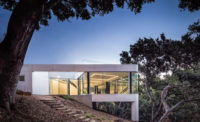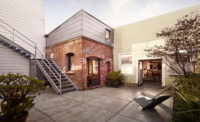Xiao-Yen's House
















Image courtesy Craig Steely Architecture

Image courtesy Craig Steely Architecture

Image courtesy Craig Steely Architecture

Image courtesy Craig Steely Architecture



















Architects & Firms
San Francisco, California
Exposing the dynamic potential of a building under construction was behind the development of the seismic exoskeleton that became one of the defining elements of Xiao-Yen’s house.
The clients are a documentary filmmaker and her husband, an artist who primarily works in assembling found objects. Over decades he has amassed a huge stockpile of old growth redwood. During early design-related conversations he expressed an interest in reusing this material as well as the existing redwood framing that would come out of the portion of the building that would be demolished. The architects were excited about the possibilities of reusing his wood and began designing in options for implementation. During this time, he carefully deconstructed nearly all of the redwood from the existing building by pulling out nails and carefully grading it for quality. The project began to be referred to as “honest sustainability” among the client and architects, meaning it required a lot of sweat equity, but would be ultimately more satisfying than just replacing an obsolete item with something new and shiny. The realm of sustainability was elevated to a higher level where the materials changed state, becoming regenerative.
The architects decided that they would reuse the redwood as the actual exterior siding. The most obvious option was to use it as a rain screen (a layer floating above the actual siding), but this more typical application was rejected as clumsy and bulky, the opposite of the preferred taut and fitted exterior. Ultimately a system was developed where a waterproof underlayment (much like wetsuit material) was installed first. The redwood was then milled into five different sizes and randomly attached to the waterproof membrane. The random pattern of the exterior siding amplifies the movement of the shadow patterns on the wall throughout the day.
Total construction cost:
$ 1.2 million
PeopleOwner Completion Date: Gross square footage: Architect Personnel in architect's firm who should receive special credit: Architect of record Engineer(s) Consultant(s) Lighting: General contractor Photographer(s) CAD system, project management, or other software used: |
ProductsStructural system: Exterior cladding Windows Glazing Doors Sliding doors: Hardware |























